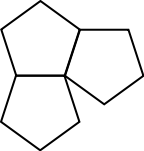Tessellation Exploration: The Basics
Objective: Find a method to tessellate the plane with any triangle. Introduce regular and semi-regular tessellations.
Materials
- Printed copy of the Tessellation Exploration: The Basics.
Exploration
Tessellations by Triangles and Quadrilaterals
- Convince yourself that the parallelogram below will tessellate the plane. Draw your tessellation on a separate piece of paper. It should cover 1/4 of your page.

- Show that a square tessellates the plane and show that a rectangle tessellates the plane. Your tessellations should cover 1/4 of your page.
- Draw an acute, an obtuse and a right triangle. Now convince yourself of the fact that two congruent copies of the same triangle fit together to form a parallelogram or a rectangle.
- Why does this imply that all triangles will tessellate the plane?
Tessellations of the Plane by Regular Polygons
A regular tessellation is a tessellation made of regular polygons, all congruent to one another. (Recall that a regular polygon has all sides congruent to one another and all angles congruent to one another. This implies the polygon is convex--why?)
A semi-regular tessellation is a tessellation made of regular polygons of two or more types so that the arrangement of polygons at each vertex is the same.
- What is the common name for a regular 3-gon?
- What is the common name for a regular 4-gon?
A tessellation is a regular tessellation if it is constructed from regular convex polygons of one size and one shape. There are exactly three regular polygons that tessellate the plane: the equilateral triangle, the square, and the regular hexagon.
 |
 |

|
Note for instance that the regular pentagon does not tessellate the plane! The figure below shows that when we try to arrange the pentagons around a vertex, then we will always have a gap or an overlap.

There are non-regular pentagons that tessellate the plane.
- Sketch the tessellation for a pentagon that looks like the outline of a house (see below) to illustrate this point.

Semi-Regular Tessellations
We can also look at tessellations formed by a combination of several regular polygons. A tessellation is a semi-regular tessellation if it is composed of regular polygons of two or more types so that the arrangement of polygons at all the vertices is the same.
- Extend the following tessellation. You should draw at least 2 more layers of polygons on each side. Is this tessellation semi-regular? Explain.
.png)
- Are the following two tessellations semi-regular or not? Explain.

Handin: A sheet with answers to all questions.
